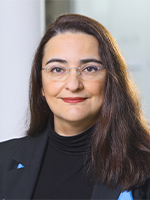Optimizing reflecting materials and photovoltaics in urban areas
Cities are the biggest energy consumers and they are going to be the major victims of climate change. Against this background, the ‚Solar Cities‘ issue is discussed nationally and internationally: cities that are gaining most of their energy need from the sun directly with their own rooftops and facades. Active houses and Solar Cities are thus planned in a way that they may retrieve a maximum of ‚solar harvest‘, directing their roofs and facades towards the sun avoiding shadowing to achieve a maximum solar yield. At best, black solar modules are used with low reflection and thus a high electricity yield with up to 20%. The major part of the absorbed solar radiation is however transformed into heat. So far there have not been developed any evaluation and simulation tools for the urban area which can estimate the effects of a broad roll-out of PV and insolation of facade surfaces in urban districts, especially on the micro-climate in street canyons.
Project description
In the project PVOPTI-Ray the influence of the reflection and the radiation balance on the performance of facade-integrated Photovoltaics is analyzed in an urban complex area. At the same time, the influence of solar modules and the radiation effects of solar modules on the urban climate are considered. Reflection from the ground and from surrounding buildings causes an increase of the solar radiation directed to the PV module, and entails an increase of the PV yield. Other factors which are influencing the performance of PV modules are energy flows which are having impact on both energy balance and temperature of PV modules. Human beings who are living in urban areas are just as well exposed to energy flows which can cause symptoms of thermal stress e.g. in the cause an increase of short-wave reflection. Supported by coupled urban climate-building models and PV yield tools optimum solutions of city planning are developed with respect to the design of city canyons and forming its surfaces. As a result, an optimized yield of façade-integrated PV plant is developed, while all bioclimatic aspects relevant for the well-being of humans are considered.
Project start: September 2016
Project duration: 12 months
Project partners
Institut für Meteorologie, Universität für Bodenkultur, Project co-ordination: Philipp Weihs
AIT Austrian Institute of Technology GmbH, Shokufeh Zamini
SmartMinerals GmbH, Stefan Krispel
Funding Line: 3rd Call ‚City of the Future‘ 2016 (Federal Ministry for Transport, Innovation and Technology)
AIT contact: Shokufeh Zamini


